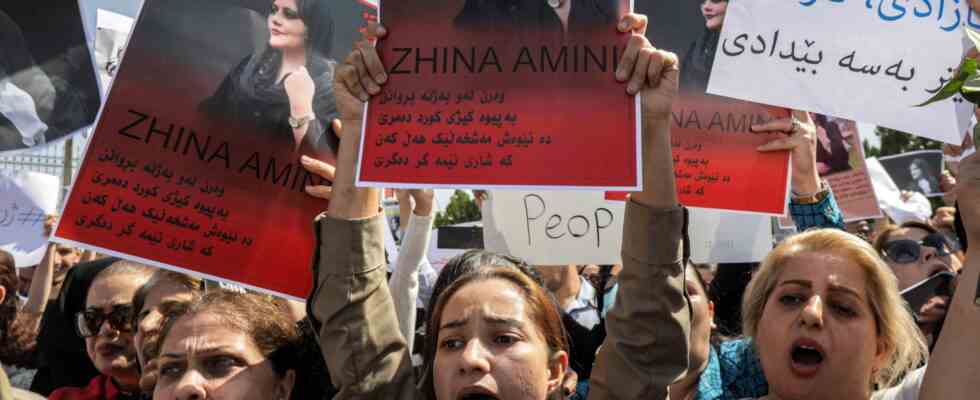Status: 07.10.2022 2:38 p.m
A good ten percent of the population in Iran are Kurdish. The young woman whose death triggered the current protest also belonged to this ethnic group. You are well connected and want more freedom.
Mahsa Amini, the young woman who died in police custody in Tehran three weeks ago, was Kurdish and had a Kurdish first name: Jina. In her hometown in Kurdistan, Iran, the first protests broke out the day after at the funeral. Since then, people from all ages and social classes have been taking to the streets, not just women and not just Kurds. Nevertheless, the question of their role in the protests arises.
Woman, life, freedom – the three words have become the slogan of these protests. “It’s a Kurdish slogan,” explains Narin Alxas from the Kurdish human rights organization Hengaw. “On the one hand, the nice thing about this slogan is that it carries a vision,” says Alxas. “And I think that’s what caused people to choose this slogan as the leading one for the protests.”
Arrested because she was Kurdish?
At the beginning, when the Tehran vice squad arrested Amini in mid-September, it didn’t matter that she was Kurdish, says Islam scholar Katajun Amirpur: “She wasn’t pulled out because she was Kurdish.”
According to Amirpur, you don’t hear from a Kurd that she is a Kurd in Iran. “It’s different for someone who comes from Azerbaijan, for example.” But the scientist doubts whether the moral police would notice that. “It was really all about the headscarf.”
Only Amini was beaten
Alxas from the human rights organization Hengaw is not sure. At least Amini didn’t know the strict controls of the moral police from her hometown Saghez in Kurdistan. In the police station, the 22-year-old was the only one of several women who were arrested with her to be beaten, reports Alxas. That could have had something to do with her origins, but it hasn’t been proven either. On Friday September 16, Amini dies in police custody.
The next day she was buried in her hometown, where the Kurds took to the streets. The protests spread very quickly. According to the Islamic scholar Amirpur, one reason for this is that the Kurds have not only suffered from discrimination and oppression since the Islamic Republic:
Kurds in Iran are traditionally better organized. They just get their people on the street faster. This is a factor that played an important role in organizing the protests.
Kurdish solidarity was awakened
Mahsa Amini is just Jina for family and friends. The first name Mahsa was purely for the Iranian authorities because Kurdish names are not allowed in official papers. A good ten percent of the population in Iran are Kurdish. They are always in conflict with the Islamic leadership in Tehran.
This has also had an impact on the current protests. “Kurds once again feel a stronger solidarity with a Kurdish woman,” says Amirpur. “That’s why in the area where she came from, the people first of all took to the streets.” The researcher also suspects that the police were more willing to use violence, since there were always fears that Kurds would attempt separatism. This in turn led to “even more Kurds taking to the streets”.
The protests in Iran, like here in the capital Tehran, are also supported by ethnic minorities.
Image: AP
Ethnic minorities are moving together
Protests quickly erupted in many cities across the country, and they continue to this day – despite massive violence by the security forces. They all have the common goal of overthrowing the regime. The human rights activist Alxas sees above all the solidarity of the ethnic minorities: “They are moving closer together. Kurds and Baluchs in particular.”
Internet only from 12:00 a.m. to 8:00 a.m
According to them, the focus of the protests is in the Iranian province of Kurdistan in the north-west. The human rights organization Hengaw, founded in 2016, collects information from across the country.
She continuously publishes videos and information, for example about fatalities and arrests: “We usually get the information directly from those affected,” reports Alxas. “Even now that the internet is down.” However, the network is not unavailable for 24 hours, according to the activist. “It always works from twelve o’clock at night until eight o’clock in the morning.” Many Kurds also have mobile phone tariffs from providers in the neighboring autonomous region of Kurdistan in Iraq. They would then have access to the Internet at any time.
“People smelled freedom”
The human rights organization also reports an incident in late September in the Kurdish city of Oschnaviyeh. Alxas calls it a moment of freedom:
The people managed to drive the regime forces out of the city for a few hours. They were already shouting ‘Freedom, freedom!’ And that was celebrated across the country. I think it’s like this this time: people smelled freedom. They have recognized that it is not unthinkable that this regime can be brought to an end.
Mahsa Jina Amini represents the anger of women, young people and ethnic minorities in Iran.
Kurds in Iran and their role in the protests
Karin Senz, ARD Istanbul, October 7, 2022 11:42 a.m

